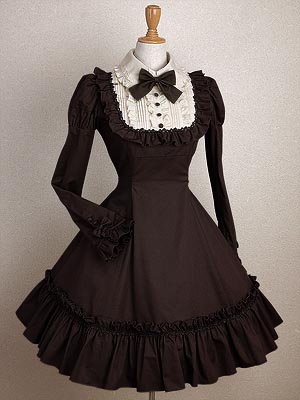Inspired by Victorian styles of dress and Rococo costumes, Lolita fashion emerged in the Harajuku area of Tokyo, Japan. Harajuku fashion, made popular in American culture by Gwen Stefani, is based in a shopping district of Japan known for the fantastical costumes worn by those who spend time there. Lolita fashion is an incredibly popular style, featuring subgroups such as 'sweet lolita' and 'gothic lolita.'
 |
| something about classic lolita enthralls me. |
Lolita fashion, characterized by bell skirts, very little exposed skin, and accessories such as parasols or wide-brim bonnets, draws from styles and silhouettes long abandoned, and adds a modern twist to make them feminine and unique.
 |
| sweet lolita can be recognized by pastel colors, pleats, frills, and bows. |
 |
| a gothic lolita skirt and sash inspired by Scottish tartans |
As I searched for different Lolita dresses online (and my eyes bugged out at the prices asked for them) I wondered why fashion has begun to draw from previous eras. Rarely before have major fashion trends been so intimately modeled on fashions from decades ago, and even more rarely have fashion trends copied as closely as possible from ideas at their peak over 100 years ago.
It might be possible today to pull a page out of a fashion magazine and hold it up to a spread from a magazine forty years old, and to not be able to tell the difference between the overarching design themes, shapes, and colors.
Why, now, has fashion begun to revert back to yesteryear? In television shows and movies from the 1950s, by the year 2011 we were all supposed to be wearing spacesuits! Instead we indulge in Victorian fashion, or even more noticeably, in fashion of the 1950s, 1960s, and 1970s.
Has fashion become less original? Or did we reach a point where improvement was no longer a possibility? I doubt that either of those questions can be answered 'yes.' Perhaps we simply use fashion as a way of connecting with our past socially and historically, and use clothing to express ideals, morals, and expectations parallel of those in the times which we emulate with fashion.
For those who are interested, there is a lolita knitters group on ravelry, a comprehensive, user-created guidebook to all things lolita, and a comparatively affordable online lolita shop.





No comments:
Post a Comment